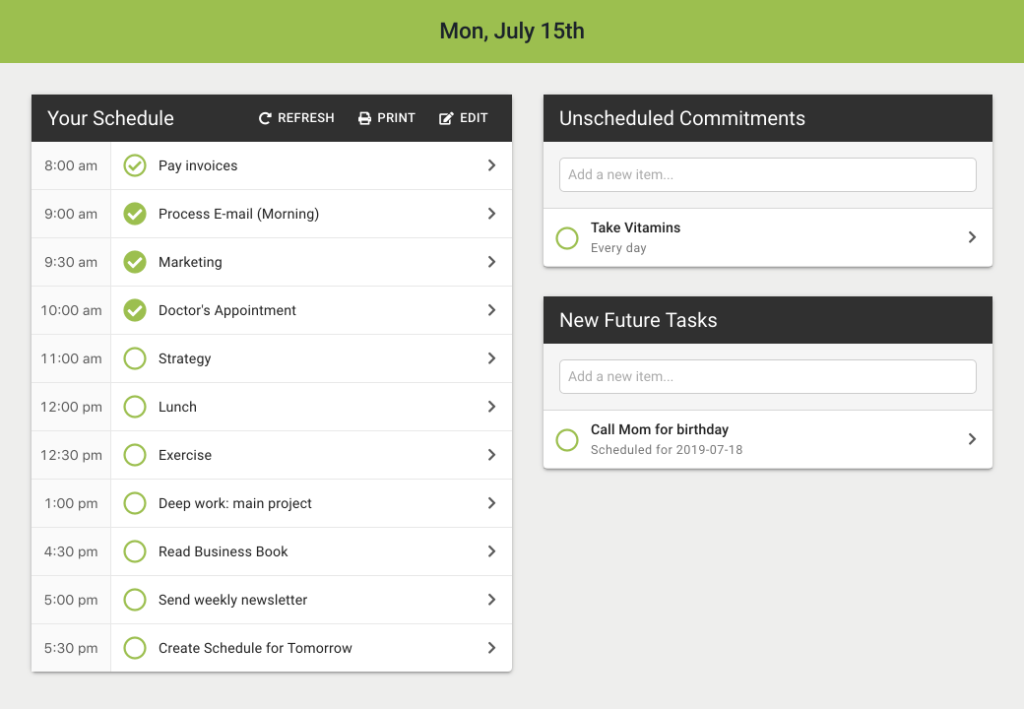Too often when we try to get something started, we aim for perfection. That desire to get things right can often backfire and cause us to take no action at all. Today I’m going to give you a roadmap to help you get started, then improve over time.
Planning is Seductive
First, let’s acknowledge that planning is seductive. We get to envision the future, where we have already accomplished everything. And we don’t have to deal with the messiness of reality.
While planning is important, for many things we want to accomplish, momentum trumps planning—at least at first.
Before we get started on any project or activity, whether that’s learning a new skill or executing a new project, we only know theoretically what challenges we might encounter. We have a vague sense of the shape of the work, but not any refined sense of how long things will take, what will be important or what we’ll enjoy doing.
Our information is incomplete.
To effectively plan long-term, we need better information. And most of the time, the best way to discover that information is to start doing the work. By starting early, we gain the momentum required to execute any plan we eventually create.
But it can be frustrating to start something before we know where we’re headed. That’s why it’s useful to have a framework for how you gain momentum. By understanding that it’s okay to not know where you’re headed initially, it can help us get started. It also helps us know when we’re stalled in one stage of the process and may need to push ourselves to reach the next level.
1. Start Haphazard
The key to gaining momentum is to get started with anything. It doesn’t have to be good. You just have to complete it, so you can get that energy rush of accomplishment.
Start off with a quick win list or the smallest step you can take toward getting going. Don’t aim for any specific goals at first; instead, aim purely for completion.
At this stage, much of what you will do will be haphazard. The timing of when you do your project or activity will be irregular, the quality of your output will be varied and the focus will shift constantly.
That’s okay.
You’re goal at this stage isn’t to execute a perfect strategy, but to gain momentum and start learning the shape of the problem—to discover what you need to know, what directions you might want to head and how to manage yourself to get there.
2. Develop a Rhythm
Once you have some momentum and are accomplishing something regularly, your next step is to develop a rhythm.
A rhythm brings consistency to your forward progress and removes the cognitive load of having to decide when to work on your project or activity. It helps you maintain momentum, without the need to restart it from scratch each time.
In this stage, you might decide to publish a new article every Monday, or to make outgoing sales calls every morning from 9:00 until 10:00.
The important thing at this stage is to create a regular cadence to when you are putting effort into your project or activity.
It also helps if you can celebrate small wins at this point, whether that’s congratulating yourself whenever you publish or after you’ve called 5 new contacts.
3. Build a Strategy
With a rhythm in place, you can start thinking strategically about your project or activity. What do you want to accomplish long-term? What goals or directions are you heading toward, and what are the steps to get there?
At this point you have solid forward momentum, so your focus should shift to steering that momentum. Ask yourself: how can I amplify the momentum I’ve created?
It’s important not to enter this phase too early. It’s easy to lose momentum by diving into strategy too early, and then forgetting to maintain your momentum as you develop your grand master plan.
Planning is important in the long-term, but plans without momentum accomplish little. Use strategy to amplify your momentum, not create it.
Summary
In summary, the 3 phases of gaining momentum are:
- Haphazard: Focus on just getting anything done
- Rhythmic: Focus on getting things done regularly
- Strategic: Focus on heading in a specific direction
Or put another way: start anywhere, make it regular, then pick a direction.
What will you start today that you’ve been putting off?








